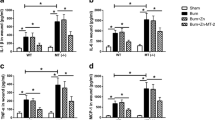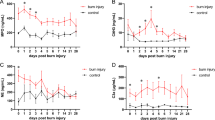Abstract
Objective and design
This prospective experimental study aims to investigate whether matrilin-2 is released from burn injury and induces post-burn inflammatory responses as an endogenous danger signal.
Subjects
Fifteen burn patients, 15 volunteers, 12 matrilin-2-deficient mice, 36 C57BL/6 mice and raw 264.7 cells.
Methods
Matrilin-2 levels were detected by enzyme-linked immunosorbent assay (ELISA) and real-time polymerase chain reaction. The inflammatory cytokines production in Matn2 deficient mice and wide type mice were detected by ELISA. Macrophages were activated by recombinant mouse MATN2 with or without adding anti-Toll-like receptor (TLR) 4 antibody. Student’s t test and one-way analysis of variance were used for statistical analysis.
Results
The matrilin-2 levels in serum of burned patients were drastically elevated as compared to those of healthy controls. The matrilin-2 levels in burned mice were significantly increased than those of non-burned controls, whereas the matrilin-2 mRNA expression was not significantly changed after burn. In addition, Matn2 deficient mice showed remarkably less inflammatory cytokines production and less neutrophil infiltration in lung. Exogenous MATN2 induced potent expression of proinflammatory cytokines production in macrophages, which was inhibited by anti-TLR4 antibody.
Conclusion
Matrilin-2 induces post-burn inflammatory responses as an endogenous danger signal, partly through a TLR4-mediated mechanism.





Similar content being viewed by others
References
Evers LH, Bhavsar D, Mailander P. The biology of burn injury. Exp Dermatol. 2010;19(9):777–83. doi:10.1111/j.1600-0625.2010.01105.x.
Hirsiger S, Simmen HP, Werner CM, Wanner GA, Rittirsch D. Danger signals activating the immune response after trauma. Mediators Inflamm. 2012;2012:315941. doi:10.1155/2012/315941.
Taylor KR, Trowbridge JM, Rudisill JA, Termeer CC, Simon JC, Gallo RL. Hyaluronan fragments stimulate endothelial recognition of injury through TLR4. J Biol Chem. 2004;279(17):17079–84. doi:10.1074/jbc.M310859200.
Merline R, Moreth K, Beckmann J, Nastase MV, Zeng-Brouwers J, Tralhao JG, et al. Signaling by the matrix proteoglycan decorin controls inflammation and cancer through PDCD4 and MicroRNA-21. Sci Signal. 2011;4(199):ra75. doi:10.1126/scisignal.2001868.
Termeer C, Benedix F, Sleeman J, Fieber C, Voith U, Ahrens T, et al. Oligosaccharides of Hyaluronan activate dendritic cells via toll-like receptor 4. J Exp Med. 2002;195(1):99–111.
Schaefer L. Extracellular matrix molecules: endogenous danger signals as new drug targets in kidney diseases. Curr Opin Pharmacol. 2010;10(2):185–90. doi:10.1016/j.coph.2009.11.007.
Jonas A, Thiem S, Kuhlmann T, Wagener R, Aszodi A, Nowell C, et al. Axonally derived matrilin-2 induces proinflammatory responses that exacerbate autoimmune neuroinflammation. J Clin Investig. 2014;124(11):5042–56. doi:10.1172/JCI71385.
Wagener R, Ehlen HW, Ko YP, Kobbe B, Mann HH, Sengle G, et al. The matrilins–adaptor proteins in the extracellular matrix. FEBS Lett. 2005;579(15):3323–9. doi:10.1016/j.febslet.2005.03.018.
Klatt AR, Becker AK, Neacsu CD, Paulsson M, Wagener R. The matrilins: modulators of extracellular matrix assembly. Int J Biochem Cell Biol. 2011;43(3):320–30. doi:10.1016/j.biocel.2010.12.010.
Piecha D, Hartmann K, Kobbe B, Haase I, Mauch C, Krieg T, et al. Expression of matrilin-2 in human skin. J Invest Dermatol. 2002;119(1):38–43. doi:10.1046/j.1523-1747.2002.01789.x.
Segat D, Paulsson M, Smyth N. Matrilins structure, expression and function. Osteoarthritis Cartilage. 2001;9(Suppl):S29–35.
Szabo E, Korpos E, Batmunkh E, Lotz G, Holczbauer A, Kovalszky I, et al. Expression of matrilin-2 in liver cirrhosis and hepatocellular carcinoma. Pathol Oncol Res. 2008;14(1):15–22. doi:10.1007/s12253-008-9005-4.
Shen CA, Fagan S, Fischman AJ, Carter EE, Chai JK, Lu XM, et al. Effects of glucagon-like peptide 1 on glycemia control and its metabolic consequence after severe thermal injury—studies in an animal model. Surgery. 2011;149(5):635–44. doi:10.1016/j.surg.2010.11.017.
Mates L, Nicolae C, Morgelin M, Deak F, Kiss I, Aszodi A. Mice lacking the extracellular matrix adaptor protein matrilin-2 develop without obvious abnormalities. Matrix Biol. 2004;23(3):195–204. doi:10.1016/j.matbio.2004.05.003.
Boucher J, Masri B, Daviaud D, Gesta S, Guigne C, Mazzucotelli A, et al. Apelin, a newly identified adipokine up-regulated by insulin and obesity. Endocrinology. 2005;146(4):1764–71. doi:10.1210/en.2004-1427.
Schmittgen TD, Livak KJ. Analyzing real-time PCR data by the comparative C(T) method. Nat Protoc. 2008;3(6):1101–8.
Xiao M, Li L, Li C, Zhang P, Hu Q, Ma L, et al. Role of autophagy and apoptosis in wound tissue of deep second-degree burn in rats. Acad Emerg Med. 2014;21(4):383–91. doi:10.1111/acem.12352.
Chipp E, Milner CS, Blackburn AV. Sepsis in burns: a review of current practice and future therapies. Ann Plast Surg. 2010;65(2):228–36. doi:10.1097/SAP.0b013e3181c9c35c.
Pape HC, Tsukamoto T, Kobbe P, Tarkin I, Katsoulis S, Peitzman A. Assessment of the clinical course with inflammatory parameters. Injury. 2007;38(12):1358–64. doi:10.1016/j.injury.2007.09.026.
Babcock GF, Hernandez L, Yadav E, Schwemberger S, Dugan A. The burn wound inflammatory response is influenced by midazolam. Inflammation. 2012;35(1):259–70. doi:10.1007/s10753-011-9313-9.
Malin D, Sonnenberg-Riethmacher E, Guseva D, Wagener R, Aszodi A, Irintchev A, et al. The extracellular-matrix protein matrilin 2 participates in peripheral nerve regeneration. J Cell Sci. 2009;122(Pt 7):995–1004. doi:10.1242/jcs.040378.
Chuffa L, Fioruci-Fontanelli BA, Mendes LO, Ferreira Seiva FR, Martinez M, Favaro WJ, et al. Melatonin attenuates the TLR4-mediated inflammatory response through MyD88- and TRIF-dependent signaling pathways in an in vivo model of ovarian cancer. BMC Cancer. 2015;15(1):34. doi:10.1186/s12885-015-1032-4.
Acknowledgments
This study was funded by the PLA General Hospital Science and Technology Innovation Fund (No: 12KMZ01), Major International (Regional) Joint Research Project Application Form (No: 81120108014) and the military logistics scientific research project (No: CWS13C076).
Author information
Authors and Affiliations
Corresponding author
Ethics declarations
Conflict of interest
The authors declare no conflict of interests.
Additional information
Responsible Editor: Ji Zhang.
Rights and permissions
About this article
Cite this article
Chi, Y., Chai, J., Xu, C. et al. The extracellular matrix protein matrilin-2 induces post-burn inflammatory responses as an endogenous danger signal. Inflamm. Res. 64, 833–839 (2015). https://doi.org/10.1007/s00011-015-0867-0
Received:
Revised:
Accepted:
Published:
Issue Date:
DOI: https://doi.org/10.1007/s00011-015-0867-0




